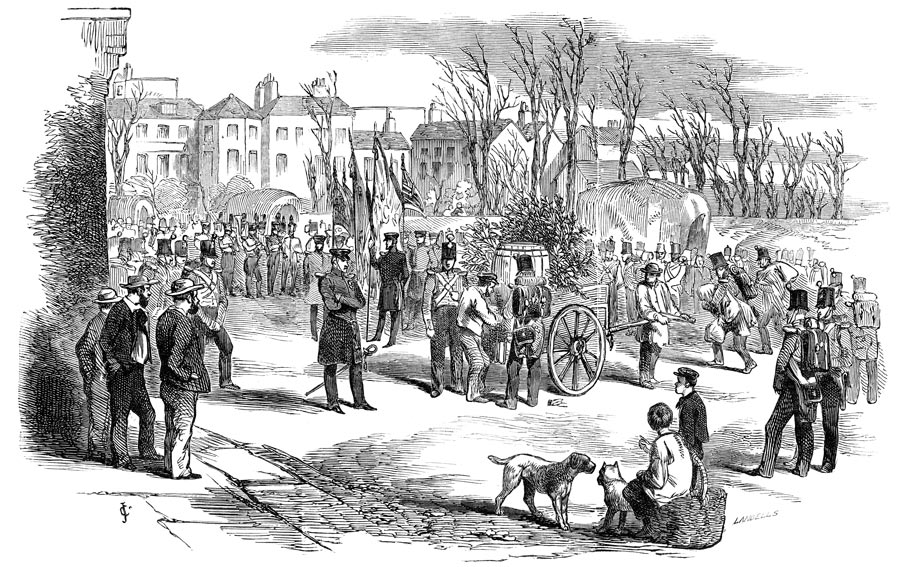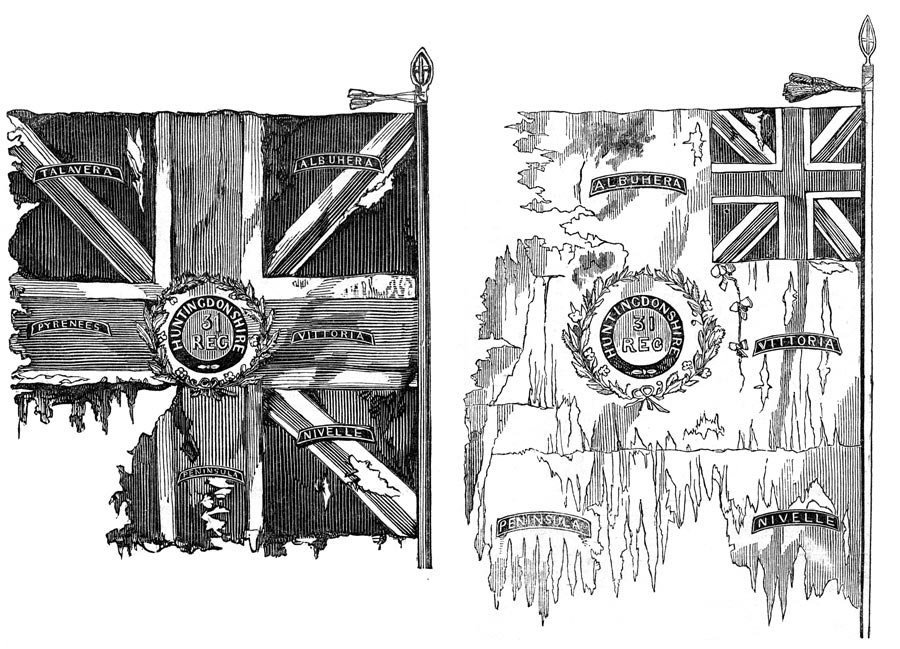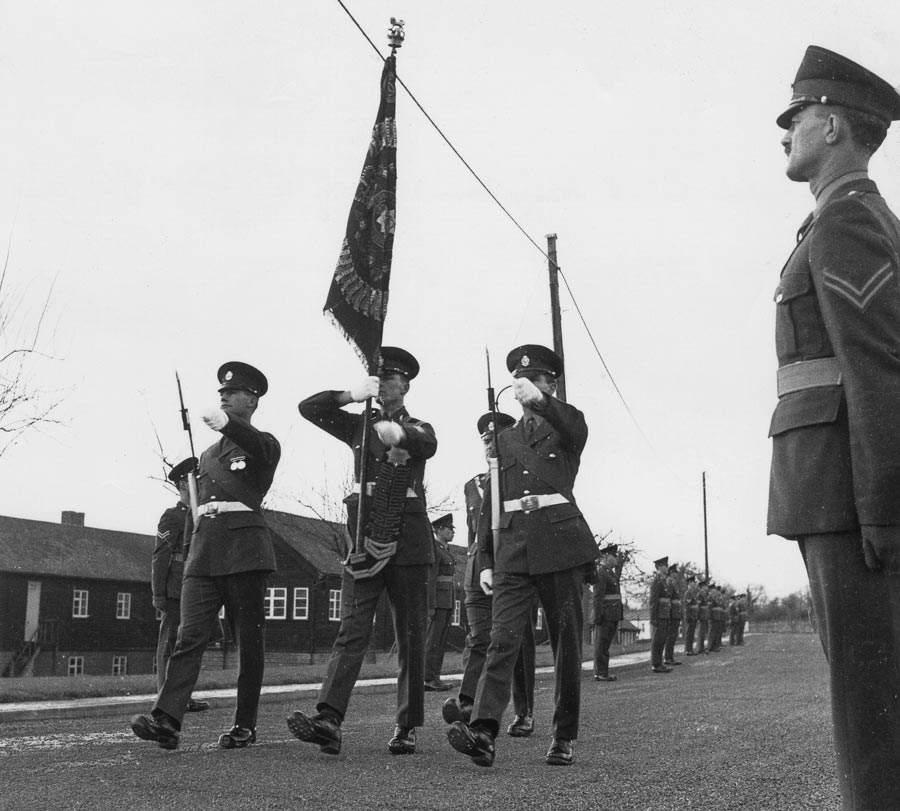The Colours of The East Surrey Regiment
(and its forebears the 31st and 70th of Foot)
Thirty-First Regiment 1827-1848
This is perhaps the best known and most famous stand of Colours of the 31st in existence. These Colours were presented at Meerut on 7th March 1827 by Lady Amherst, wife of the Governor General of India, to replace those lost in the Kent. A contemporary account by Edward Ward Walter Raleigh describes the occasion:
“On arrival [at 4.30 pm] at the parade ground a salute of artillery was fired. On the Governor General and the ladies approaching, the 31st, drawn up in line, gave a General Salute by presenting arms, with the band playing God Save the King. General Reynolds and Lieutenant Colonel Cassidy then riding up to the saluting base gave Lady Amherst the necessary instructions, and delivered to Her Ladyship the new Colours. The Regiment now marched round, the band playing the 31st march, and formed into a centre and two side columns. . . The two junior ensigns now advanced up to Lady Amherst, and kneeling received from her the new Colours, on which the Regiment gave three cheers. Lord Amherst now made a very feeling speech, in which he alluded to the melancholy circumstances under which the Regiment had been deprived of its Colours. He expressed his conviction that under every circumstance of warfare the 31st would support the representatives of those banners under which they had often gloriously conquered. The Regiment then formed line and again presented arms. The artillery saluted and the regiment marched past with their Colours flying and their band playing the 31st march [presumably Lord Charles Montague’s Huntingdonshire March].” |
 |
| Figure 41 |
These Colours were borne throughout the Afghan campaign of 1842, and the Sutlej (Sikh) actions of 1845, when the Regiment earned undying fame during the bitterly fought actions of Moodkhee, Ferozeshah, Aliwal and Sobraon. At Moodkee in December 1845, the entire Colour party was shot down, and immediately Quartermaster Sergeant Jones dashed forward, took the Colours from the hands of the dead Ensigns, and carried them himself for the rest of the battle. For his distinguished conduct, Jones was immediately awarded a commission in the Regiment. This episode has been somewhat overshadowed by the action at Sobraon, fought on 10th February 1846, when during a third attempt made on the Sikh positions, the Ensign carrying the Queen’s Colour, Lieutenant Tritton, was killed and another officer, Lieutenant Noel, snatched it up. As he carried it in front of the Regiment, the staff was smashed in his hand by enemy fire. The officer bearing the Regimental Colour – none other than Ensign Jones - was then killed. The pike of the latter was seized by Sergeant Bernard McCabe, who rushed forward and planted the Regimental Colour on the highest point of the enemy’s fortifications. He held his position under a withering fire. The Regiment followed, driving the Sikhs before them, and the attack was everywhere successful. Sergeant McCabe, later commissioned into the 32nd Foot, was killed at Lucknow in 1857 during the Indian Mutiny.
 |
| Figure 42 |
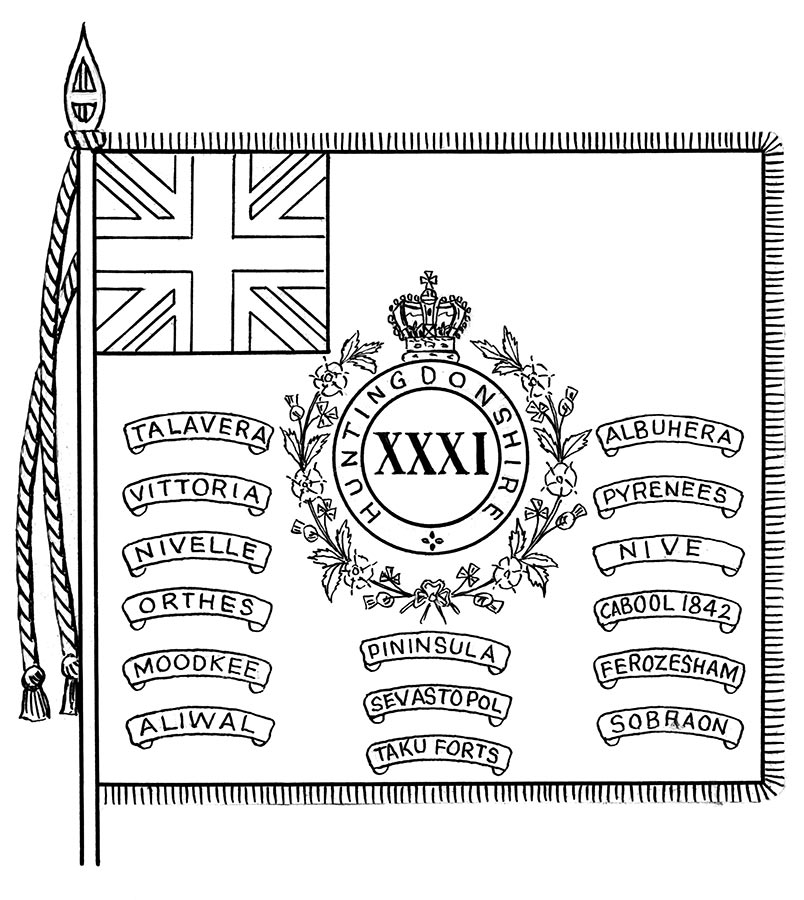 |
| Figure 43 (Click to enlarge) |
On the return home of these Colours, the Illustrated London News of the 12th December 1846 described them as “torn to shreds from the storm of grapeshot through which they were victoriously borne, and stained with the blood of the Ensigns who were killed carrying them”. The
Figure 44 The Colours of the 31st in Canterbury Cathedral. |
|
These Colours were carried on parade for the last time in 1848, and in 1850, on the fourth anniversary of Sobraon, were laid up in Canterbury Cathedral. Here they can be seen to this day. The scrolls on the Queen’s Colour are yellow, the central device is red ground with gold lining. The numerals are arabic, and these are also in gold. The scrolls on the Regimental Colour are probably blue, but due to fading of the material over the years it is very difficult to say with certainty if this was the case. The ground colour of this Regimental Colour is buff.
The return of the 31st from the Afghan Campaign |
||
On the evening of the 6th, the bead-quarters marched into Chatham garrison, from Gravesend, by the Rochester and Gravesend Railway, where they were met by the very superior band of the Royal Marines. On their arrival at the Rochester terminus, the band struck up "God save the Queen," and these heroes of the SutIej were greeted by hundreds of people with loud and repeated huzzas. The soldiers, in return for this spirited welcome, waved the five colours captured from the enemy–one from Ferozeshah, two at Aliwal, and two taken at Sobraon. These banners bear testimony of the severe engagements. The Queen's colours and the regimental colours of the regiment are complete fragments. The headquarters were also accompanied by the depot band, which played, at intervals, in passing with the regiment through the streets of Rochester and Chatham, and were greeted along the whole line by thousands of people who assembled to witness their return. Out of 215 men, there are but 80 unwounded. Lieutenant-Colonel James Spence and Quarter-Master Bennison are the only two officers now with the regiment that went out with it in the Kent East Indiaman, when it took fire and sunk in the Bay of Biscay. The following officers have come home with the head quarters:– Major James Staunton, Major D. F. G. Longwood, Lieutenant G. Elmslie, Lieutenant H. P. Hutton, Lieutenant R. Mackenzie, Lieutenant T. Scarman, Quarter-Master S. Bennison, Assistant-Surgeon H. C. Foss, and Adjutant A. Bolton. Lieutenant-Colonel James Spence headed the troops. The officers of this regiment having been on the most friendly terms with the Royal Marine Corps, and being members of the mess of the Royal Marines, they dined at the Royal Marines' mess-room with the officers, who invited them, on their arrival at the garrison, to a superb repast. |
||
|
||
Annexed is a synopsis of the recent services of the 31st in India:– On the 12th of December, 1845, the regiment marched from Umballa for the frontier then consisting of 31 officers and 844 non-commissioned officers, drummers, rank and file. The following officers were killed, or died of their wounds:–Colonel Bolton, C.B., Aide-de-camp to the Queen; Major Baldwin; Captain Willis Lieutenants Pollard, Hart, Bernard, Brenchly, Tritton; Ensign Jones; Assistant Surgeon Gahan, 9th Foot, doing duty with 31st; total, 10. Officers wounded:– Lieutenant-Colonel Byrne; Captains Bulkeley, Young, Garvock, Lugard; Lieutenants Plasket, Law, Atty, Elmslie, Gabbett, Timbrell, Pilkington; Ensigns Paul, Hutton; Lieutenant and Adjutant Bolton; total, 15. Officers that were in all the actions and escaped:– Lieutenant-Colonel Spenee, Captain Longworth; Lieutenants Robertson, Noel; Quarter-Master Bennison, Captain White also (but was not at Aliwal and Sobraon); total, 6. Lieutenant-Colonel Spence commanded a brigade under Sir Harry Smith, on the 10th of February, at Sobraon; and Captain Longworth commanded the regiment at Sobraon, and had the command of it from the 4th of February to the 12th. Deducting baggage and camp guards, about 733 came into action, and the casualties, amounted 531. (London Illustrated News - Dec. 19 1846) The Indian Colours taken at Alcany, Aliwal, Zublan & Ferozeshah |
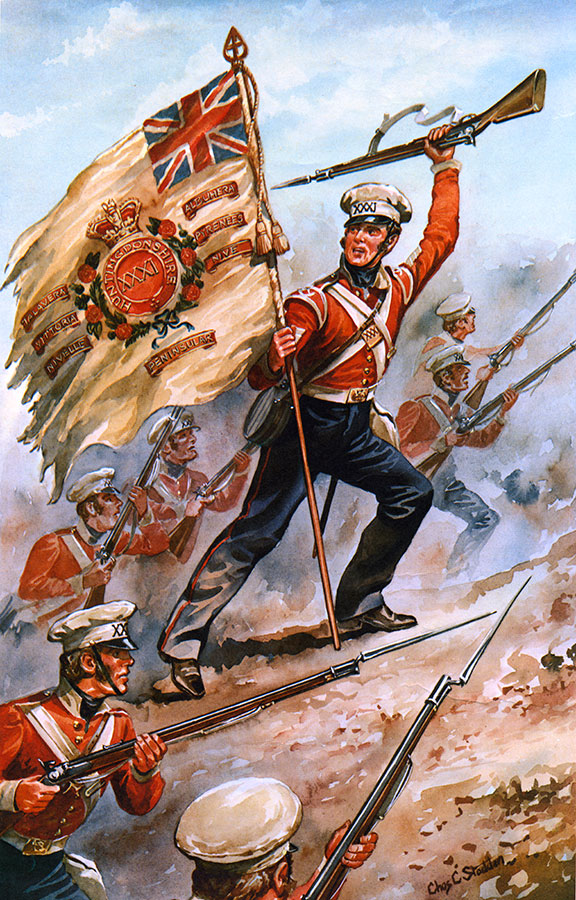 |
Figure 45 |
The names of the officers killed carrying them are inscribed on silver plates fastened to the pikes. A photograph in the November 1951 issue of the Journal of the East Surrey Regiment shows the Colours to be very thin – they were hung untouched for over one hundred years until 1951, when they were netted and rearranged to project horizontally. More recent visits reveal that the spearpoint finial is missing from Sergeant McCabe’s Colour. Only two thirds of the Queen’s Colour now remains and the now missing Battle Honour scrolls are thought to be, from top to bottom, ‘ORTHES’ ‘PYRENEES’ AND ‘PENINSULA’. This is how they are depicted on the memorial under the stand.
Figure 46
Sobraon Day, Lingfield 1970, Sgt M D Maloney is the Sobraon Sergeant.
(Click to enlarge)
On the anniversary of Sobraon each year, commitments permitting, the Regimental Colour of the 1st Queen’s was marched with all ceremony to the Warrant Officers’ and Sergeants’ Mess, into whose care it was given for the day. This practice has since been adopted by the Princess of Wales’s Royal Regiment.


